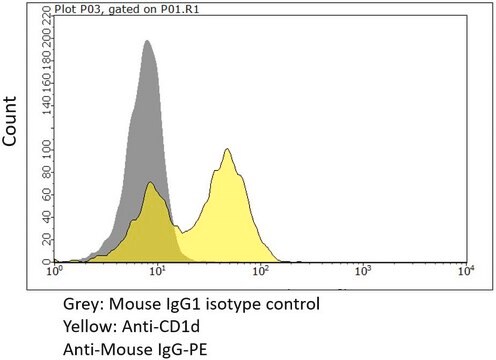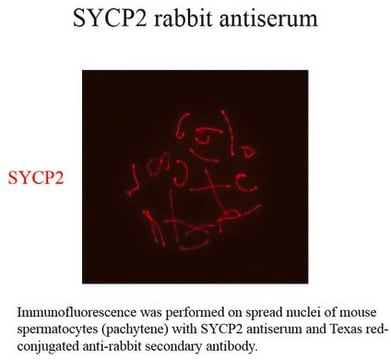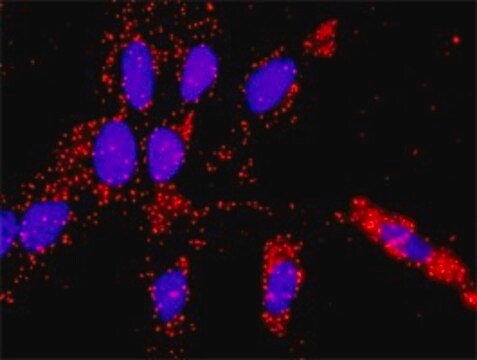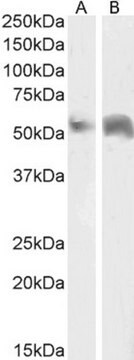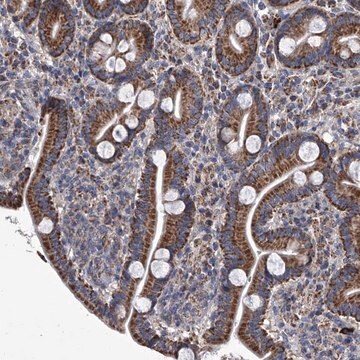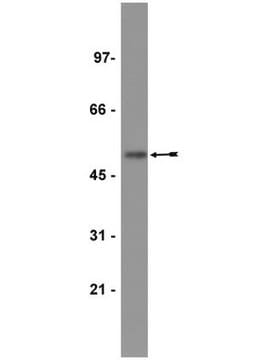MABC983
Anti-CD1d Antibody, clone D5
clone D5, from mouse
Synonyme(s) :
Antigen-presenting glycoprotein CD1d, R3G1, CD1d
About This Item
Produits recommandés
Source biologique
mouse
Niveau de qualité
Forme d'anticorps
purified antibody
Type de produit anticorps
primary antibodies
Clone
D5, monoclonal
Espèces réactives
human
Technique(s)
immunoprecipitation (IP): suitable
western blot: suitable
Isotype
IgG2bκ
Numéro d'accès NCBI
Numéro d'accès UniProt
Conditions d'expédition
wet ice
Modification post-traductionnelle de la cible
unmodified
Informations sur le gène
human ... CD1D(912)
Description générale
Immunogène
Application
Apoptosis & Cancer
Apoptosis - Additional
Western Blotting Analysis: A representative lot detected exogenously expressed CD1d in CD1d-transfected C1R human lymphoblastoid cells (Kim, H.S., et al. (1999). J Biol Chem. 274(14):9289-9295).
Immunoprecipitation Analysis: A representative lot immunoprecipitated intact as well as degraded CD1d from human penile urethral epithelial (PURL) cells following C. trachomatis (Kawana, K., et al. (2007). J Biol Chem. 282(10):7368-7375).
Immunoprecipitation Analysis: A representative lot immunoprecipitated exogenously expressed CD1d independent of glycosylation states from lysates of CD1d-transfected FO-1 human melanoma cells (Kim, H.S., et al. (1999). J Biol Chem. 274(14):9289-9295).
Qualité
Western Blotting Analysis: 4.0 µg/mL of this antibody detected CD1d in 10 µg of THP-1 cell lysate.
Note: Longer exposure time is needed when using total lysates for Western blotting applications. Membrane preparation or immunoprecipitation can be employed to enrich membrane target proteins prior to Western blotting.
Description de la cible
Forme physique
Stockage et stabilité
Autres remarques
Clause de non-responsabilité
Vous ne trouvez pas le bon produit ?
Essayez notre Outil de sélection de produits.
Code de la classe de stockage
12 - Non Combustible Liquids
Classe de danger pour l'eau (WGK)
WGK 1
Point d'éclair (°F)
Not applicable
Point d'éclair (°C)
Not applicable
Certificats d'analyse (COA)
Recherchez un Certificats d'analyse (COA) en saisissant le numéro de lot du produit. Les numéros de lot figurent sur l'étiquette du produit après les mots "Lot" ou "Batch".
Déjà en possession de ce produit ?
Retrouvez la documentation relative aux produits que vous avez récemment achetés dans la Bibliothèque de documents.
Notre équipe de scientifiques dispose d'une expérience dans tous les secteurs de la recherche, notamment en sciences de la vie, science des matériaux, synthèse chimique, chromatographie, analyse et dans de nombreux autres domaines..
Contacter notre Service technique